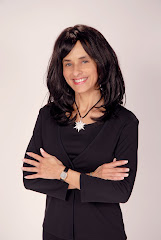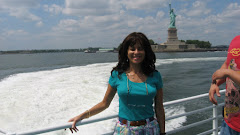Museum visits in the Caribbean.
Yes, I will admit it, I took an 11-day Southern Caribbean cruise that included five port stops in St. Thomas, St. Kits, St. Lucia, Curacao, and Aruba, and I actually visited history museums in two cities.
The Kura Hulanda museum in Willemstad, Curacao and The National Archaeological Museum in Oranjestad, Aruba. Of note, both islands are parts of the (former) Dutch Empire. Surprisingly, I was greeted in all the shops with words in Spanish.
The sail-in was lovely as I saw all the bright, pastel gingerbread buildings, the turquoise blue water in the canals underneath the Queen Emma Bridge, and the vendors setting up their colorful wares alongside the port.
As I disembarked the cruise ship, I walked over to the vendor area and listened to the sales pitches of several tour operators. I was immediately sold on the first gentleman with whom I spoke. He showed me a map that highlighted all of the points of interest on the tour, in a van minivan,--a two hour tour in an air-conditioned vehicle, for only $20.
Since I had not taken any tours on my first three ports of call, I decided I would like to visit this lovely island.
Here are some of the things that I learned: Curacao probably means “healing island” in Portuguese. Curaçao has 100 UNESCO monuments and 80 plantation homes; Jews were a very powerful economic force here since the Dutch took them in after they were expelled from Spain; there is free Wi-Fi in the downtown area of the capital city; they have 0.5% crime, they are 3 to 4 hours away from Venezuela by boat, the leading industries in order of importance are oil, tourism, ship repair/dry dock, and they are a free zone.
Curaçao was a major player in the slave trade because the Dutch were leaders in the international slave trade. Taking over major Portuguese trading posts on the west coast of Africa, they purchased enslaved Africans and transported them to Curaçao and Brazil, where they were sold to wealthy plantation owners from across the Americas. Curaçao became one of the largest slave depots in the Caribbean. By the time the last slave galleon arrived in the harbor in 1788, the Dutch had transported some 500,000 Africans to slavery.
The tour lasted from 10:20 AM until 12:20.
It was a delightful two-hour tour where I was able to witness the beauty of this island.
The next part of my visit to this charming island was not beautiful.
I visited the little-known museum dedicated to the Atlantic slave trade and slavery in the Americas.
I left the port area, map in hand, searching for the museum. I knew I was close but uncertain of precisely which street to take so I asked a policeman for help. He stopped what he was doing walk to me for a block and a half and pointed at the tiny street where the museum is located. Such hospitality!
Our tour guide informed me that our bus driver’s wife conducted tours of this museum. I sought out Evelaine there. I found her to be rather dour and depressing and I could only understand one out of every five or six words because her English was a very difficult understand. Fortunately, I am aware of much of this history and there was a clear signage throughout each exhibit.
There were exhibits on The Arab slave trade, the Atlantic slave trade, slavery in different parts of the Americas, slavery in the US, Blacks in the USA- from slavery to civil rights, the middle passage and more.
Included in this museum is a concentrated collection, one of the few worldwide, of artifacts such as: part of a hull of a slave ship, traps used to entrap perspective slaves in West Africa, 2 Ku Klux Klan robes, newspaper clippings, signage, and posters communicating various elements of the slavery industry dating as far back as the 1600s.
I was moved by this historically accurate, compelling, in-your-face, no-holds-barred, portrayal of the brutality inflicted upon a people all driven by wide scale greed. Empires derived massive wealth and famous corporations such as Lloyd's of London attribute their origins to profits from the Atlantic slave trade.
After my tour ended with the guide, I went back and reviewed many of the sections on the trans-Atlantic slave trade, the role of European empires in slavery in Africa, the history of blacks in the USA, and more, on my own.
In all, I spent at least two hours in the museum.
After the visit, I took the exhilarating walk across the Queen Emma Bridge from Otrabanda to the Punda side of Willemstad. I enjoyed the walk across the bridge, creepily shaky at times, and lined with colorful colonial buildings along the waterfront.
Punda--found it to be a bit commercial as it was peppered with souvenir shops, designer shops, and tacky clothing shops, something I could see anywhere. The architecture, well preserved from Dutch colonial days, is intriguing. On my next visit, I will actually visit the floating market known for its Venezuelan ships laden with tropical fruits and vegetables that arrive early every morning.
This museum provides an interactive educational experience celebrating more than 5000 years of Amerindian culture. Unlike the rest of the Caribbean, Aruba was not involved in African slavery nor in broad scale agriculture using African slaves. According to Henry Loius Gates, Aruba has virtually no African past. Today, only 20% of Arubans are descendants of Africa, rather 40% are European and 40% are Amerindian. I cannot believe that Siri knows the word Amerindian, including how to spell it with an A.
It was the only part we visited on this itinerary with the faces of the residents were not 99% Black or East Indian (shopkeepers).
Here I learned that the primary industry (after Aruba was dismissed by the Spanish crown as a useless in the 1500s), was ranches (horses, donkeys, and goats) and ship repair by the Dutch who conquered the island in 1636.
I enjoyed my visit to this charming museum and gain a true appreciation for Aruba's history here. Of note, the museum is only a 10 minute walk from the port.
After leaving the museum, I walked through the surrounding streets that were lined with shops and restaurants, mostly filled with souvenirs and electronics. Nothing distinctive.
I learned a lot from my visits to history museums on 2 Caribbean islands on my 11 day southern Caribbean cruise.
I recommend them both.
update: I just read a question posted on Facebook by a cruise director from a major cruise line. He asked readers to discuss their favorite activities in the ports of Aruba and Curaçao. Out of 190 comments, no one mentioned a museum. I know I am in anomaly.








































.jpg)
.jpg)




No comments:
Post a Comment